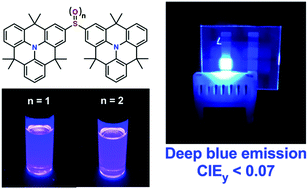Bis(hexamethylazatriangulene)sulfone: a high-stability deep blue-violet fluorophore with 100% quantum yield and CIEy < 0.07†
Abstract
Efficient deep blue-violet fluorophores are highly sought after as emitters for OLEDs and as labels for fluorescent imaging. Despite significant progress in the development of deep blue luminescent materials, highly efficient emitters in the deep-blue/violet region of the visible spectrum with good photostability remain rare. Here we describe the preparation of two violet-blue emitters based on hexamethylazatriangulene (HMAT) donors and weakly accepting sulfone and sulfoxide acceptors, with CIE coordinates in solution as low as (0.16, 0.02) and quantum yields of unity. By restricting freedom of motion in the HMAT donor, stability of the sp2 C–N bonds is increased significantly, increasing photostability over controls with nonplanar donors while also narrowing the emission bandwidth to 39.5 nm FWHM. These materials were then evaluated in proof-of-concept experiments for both two-photon excited fluorescence and as emitters in OLEDs to demonstrate their potential applications in optoelectronics.



 Please wait while we load your content...
Please wait while we load your content...